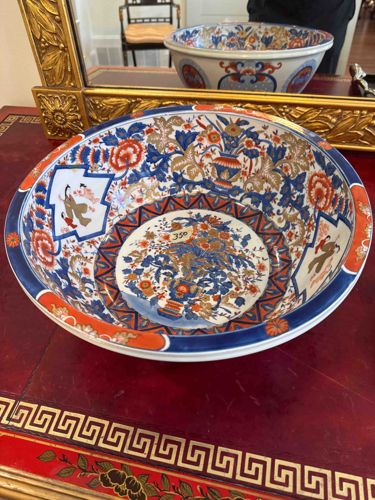
Japanese Imari-Style Porcelain Charger or Bowl
This item is a large, circular porcelain charger or bowl, decorated in the distinctive Japanese Imari style. The primary color palette consists of rich cobalt blue, vibrant iron red (referred to as 'aka-e'), and intricate gold accents, with some additional elements in a muted green-gold hue. The decoration is densely applied, covering almost the entire interior surface. The central medallion features an elaborate floral arrangement with chrysanthemums and other traditional motifs, predominantly in blue and gold, with hints of red and green-gold. Surrounding this central design is a band of geometric patterns, likely stylized waves or interlocking shapes. The main body of the bowl's interior is divided into several larger panels and smaller borders. These panels depict a variety of scenes and motifs, including finely detailed floral branches, exotic birds possibly peacocks or phoenixes, and stylized cloud formations. There are also two distinct cartouches visible: one rectangular cartouche on the left side features two elegantly dressed figures, likely geishas or court ladies, rendered in red, gold, and blue on a white ground. Another visible cartouche to the right, partially obscured, appears to have similar figural or symbolic representations. The rim of the bowl is edged with a wide band of cobalt blue, further adorned with gold and red floral motifs. An orange-red band with geometric patterns runs just below the rim. The exterior of the bowl, partially visible in the reflection, also features blue and red decorative elements, suggesting a consistent decorative scheme. The visible craftsmanship appears high, with fine brushwork and detailed imagery, characteristic of quality Imari ware. The condition seems generally good, with no obvious chips, cracks, or significant repair, although a precise assessment would require closer inspection. There is a small handwritten number '350' in black ink on the central medallion, likely a dealer's or auction house's inventory or price mark. Based on the intricate design and color palette, this piece likely dates from the Meiji period (1868-1912) or early 20th century, though without a clearer view of the base or manufacturer's marks, a definitive age is difficult to ascertain.
AI-Generated Appraisal Disclaimer
Estimated Value
$400-600
Basic Information
Category
Decorative Arts - Ceramics
Appraised On
November 23, 2025
Estimated Value
$400-600
Item Description
This item is a large, circular porcelain charger or bowl, decorated in the distinctive Japanese Imari style. The primary color palette consists of rich cobalt blue, vibrant iron red (referred to as 'aka-e'), and intricate gold accents, with some additional elements in a muted green-gold hue. The decoration is densely applied, covering almost the entire interior surface. The central medallion features an elaborate floral arrangement with chrysanthemums and other traditional motifs, predominantly in blue and gold, with hints of red and green-gold. Surrounding this central design is a band of geometric patterns, likely stylized waves or interlocking shapes. The main body of the bowl's interior is divided into several larger panels and smaller borders. These panels depict a variety of scenes and motifs, including finely detailed floral branches, exotic birds possibly peacocks or phoenixes, and stylized cloud formations. There are also two distinct cartouches visible: one rectangular cartouche on the left side features two elegantly dressed figures, likely geishas or court ladies, rendered in red, gold, and blue on a white ground. Another visible cartouche to the right, partially obscured, appears to have similar figural or symbolic representations. The rim of the bowl is edged with a wide band of cobalt blue, further adorned with gold and red floral motifs. An orange-red band with geometric patterns runs just below the rim. The exterior of the bowl, partially visible in the reflection, also features blue and red decorative elements, suggesting a consistent decorative scheme. The visible craftsmanship appears high, with fine brushwork and detailed imagery, characteristic of quality Imari ware. The condition seems generally good, with no obvious chips, cracks, or significant repair, although a precise assessment would require closer inspection. There is a small handwritten number '350' in black ink on the central medallion, likely a dealer's or auction house's inventory or price mark. Based on the intricate design and color palette, this piece likely dates from the Meiji period (1868-1912) or early 20th century, though without a clearer view of the base or manufacturer's marks, a definitive age is difficult to ascertain.
Get Your Items Appraised
Instant estimates of your treasures with AI-powered instant appraisals